Introduction > The Bullet > The Cartridge > Loading
The paper used in the manufacture of the cartridges is given coverage by Hawes, and it is interesting to note that two different grade papers are employed. The “wrapping,” or cartridge paper used in making the cylinder which contains the powder, is a thicker paper than the outside forming paper. The papers are machine cut although they can also be cut to size using tin patterns.
Two tools are used in the rolling of the cartridges, the “former” and the “plug”. The “former” is a cylindrical piece of wood or metal, upon which to roll the cartridge paper. It has a hollow or cup at one end, into which some of the paper is pressed by means of the “plug,” to form the hollow for the point of the bullet. The tools are made pierced with an air-hole; this prevents the paper from collapsing in withdrawing it after rolling. Once rolled and the bullet secured all that remained was for the cartridge to be filled, twisted, and greased or lubricated.
The empty cartridges were conveyed in boxes by means of wagons to the cartridge-sheds, which were small isolated buildings. Machines were used to fill the cartridges after which they were inspected. Having passed inspection the box containing the cartridges was marked and passed on to the next process.
The superfluous paper at the top of the cartridges was twisted from left to right and pressed down upon the powder at the same time. This done, the cartridges were taken to be lubricated, or dipped. They were fixed in trays which left just that portion alone projecting from the bottom which it was necessary to lubricate. Hawes writes that wax alone was used for the lubrication, or anti-fouling composition, and that is was heated by steam at a temperature of 230° Fahrenheit. The trays of cartridges were placed besides the dipping-pans on metal plates heated by steam until they were thoroughly dry and acquired some slight degree of heat. Each tray was then successively dipped, removed and left to cool thoroughly before packing. For field use or other situations when the cumbersome dipping apparatus was not available, a copper lubrication kettle was available.
Hawes gives much detail on all the operations and continues with discussion of packing and labelling the cartridges, the manufacture of blank and Sharps’ cartridges, consideration of lubrication, the manufacture of percussion caps and more. For those of you with a thirst for more detail but who do not have access to Hawes scarce work, it has been reprinted in the USA. The original text has been reset for this soft back book which also includes copies, at reduced size, of the original line drawings. The reprint includes a photographic supplement showing bullets, cartridges, original packaging, moulds and an Anderson bullet machine. [ISBN 1-57747-100-8 – Thomas Publications, P.O. Box 3031, Gettysburg, Pa. 17325, USA – www.thomaspublications.com].
Mindful that soldiers may find themselves in the position of having to manufacture their own cartridges, recruits were instructed on their method of manufacture. The following extract from a Musketry Instructors manual of 1853 explains the process. Note that the accompanying illustrations have been extracted from Hans Busk’s “Handbook for Hythe,” (London, 1860 and reprinted by Richmond Publishing Co. Ltd., Surrey, England 1971- SBN 85546 156 X), as those from the manual will not reproduce well. The two sources are however essentially the same in detail.
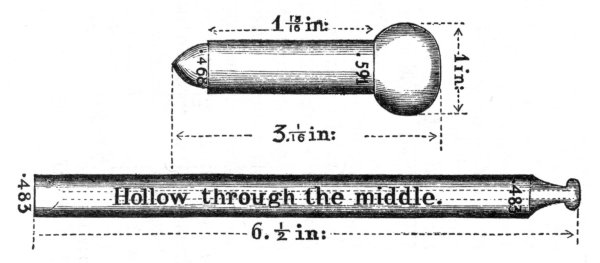
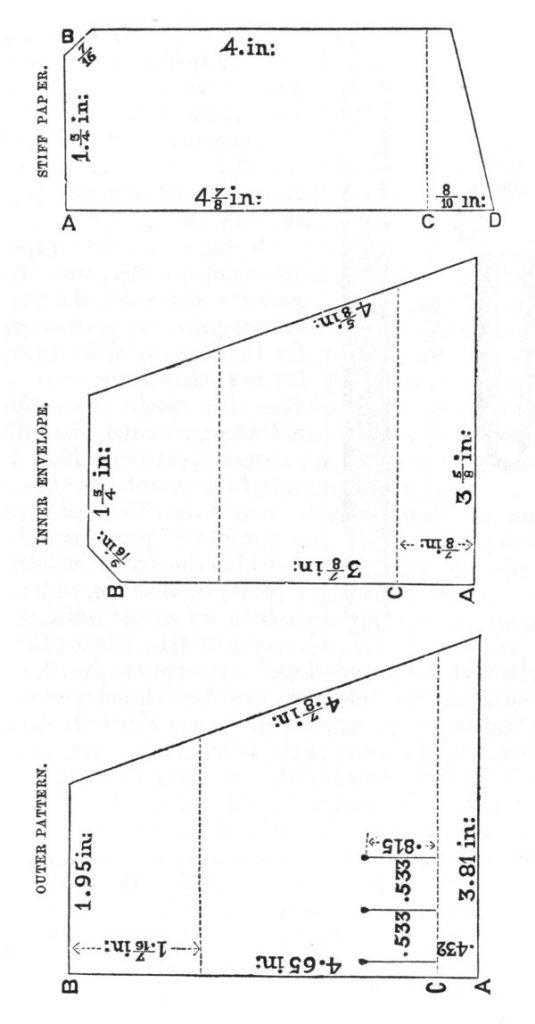
Manufacture of Cartridges
Having cut the paper according to the size and patterns shown, for cartridges for the rifle-musket or carbine,-
- Form the powder case. Roll the “stiff paper” pattern, tightly about 2½ times round the “mandrel,” which is to be laid on the side opposite the acute angle, or AB, with its base coincident with the broader side, or AD; then place the “inner envelope” paper pattern No.2, on the top of the stiff paper with the side opposite the acute angle, or AB, of the former about ¾ of an inch from the acute angle, of CD of the latter, and role said envelope tightly on the stiff paper and mandrel; after which slightly twist the end that overlaps about 7/8 of an inch, or AC, and fold it into the hollow at the base of the mandrel, making use of the point of the “former,” to close the folds and adapt the paper to the cavity, which is to receive the point of the bullet, being careful to secure the bottom of powder-case, so that no powder can escape therefrom.
- Unite the bullet with the powder-case. Put the point of the bullet well into the cavity of the powder-case, and place both so fixed on the side of the “outer envelope” paper opposite the acute angle, AB, and about ½ an inch from the broader, or AC; roll the “outer envelope” tightly round the bullet and powder-case, with the mandrel still in it, the twist or fold the paper that overlaps, and tie it as close as possible to the base of the bullet; after which place the base of the cartridge on the table, and withdraw the mandrel with care, by pressing the powder-case with one hand while raising the mandrel with the other, so as not to separate the powder-case from the bullet, both of which must be kept as close as possible to prevent any play at the juncture, which would soon render the cartridge unserviceable.
- Charge the powder-case. Place a funnel into the mouth of the powder-case and pour 2½ drams of powder or a less quantity, according to the arm used, into it; remove the funnel, being careful that none of the powder escapes between the inner and outer envelopes; and secure the charge by squeezing the tops of the two envelopes close to the stiff paper of powder-case, and giving them a slight twist with a pressure inwards, laying the ends on the side of the cartridge. The slits in the outer envelope are made to facilitate its detachment when fired.
- Lubricate the cartridge. The cartridge being complete, dip the base up to the shoulder of the bullet, in a mixture composed of 5 parts of bees-wax and 1 part of tallow.
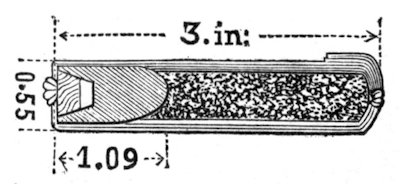
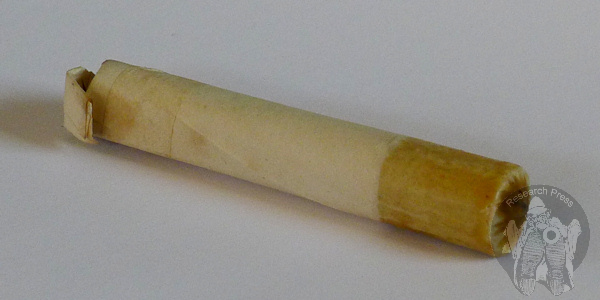
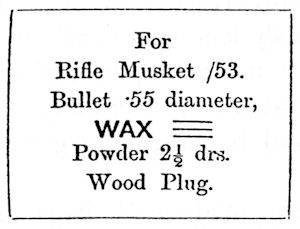
Cartridges were packed in bundles of ten. And each packet labelled as shown.
The word “wax” signifies that the lubrication is composed of wax unmixed, and the three lines represent that the outer forming paper has received the three cuts illustrated in the ‘outer pattern’ paper diagram.
The packets were fastened with strong twine, and carefully packed in barrels, by being built round the sides; a cylinder of caps being placed in the centre, in the proportion of 75 caps for every 60 rounds.